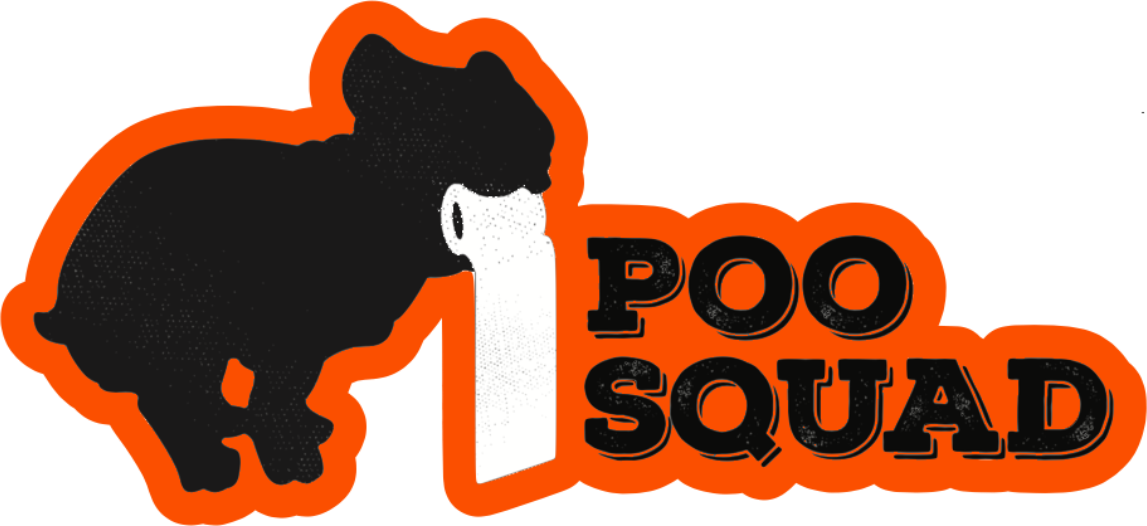Dog poop is not good for grass, it burns roots, unbalances soil pH, and spreads harmful bacteria. Unlike manure from herbivores, dog waste contains too much nitrogen and pathogens. Cleanup is critical for lawn health, safety, and long-term soil recovery.
Dog poop is often misunderstood as natural fertilizer, but ask any lawn expert and they’ll tell you: it’s closer to a toxin than a treatment. The idea that it “feeds grass” comes from confusion with farm manure, but the biology doesn’t check out.
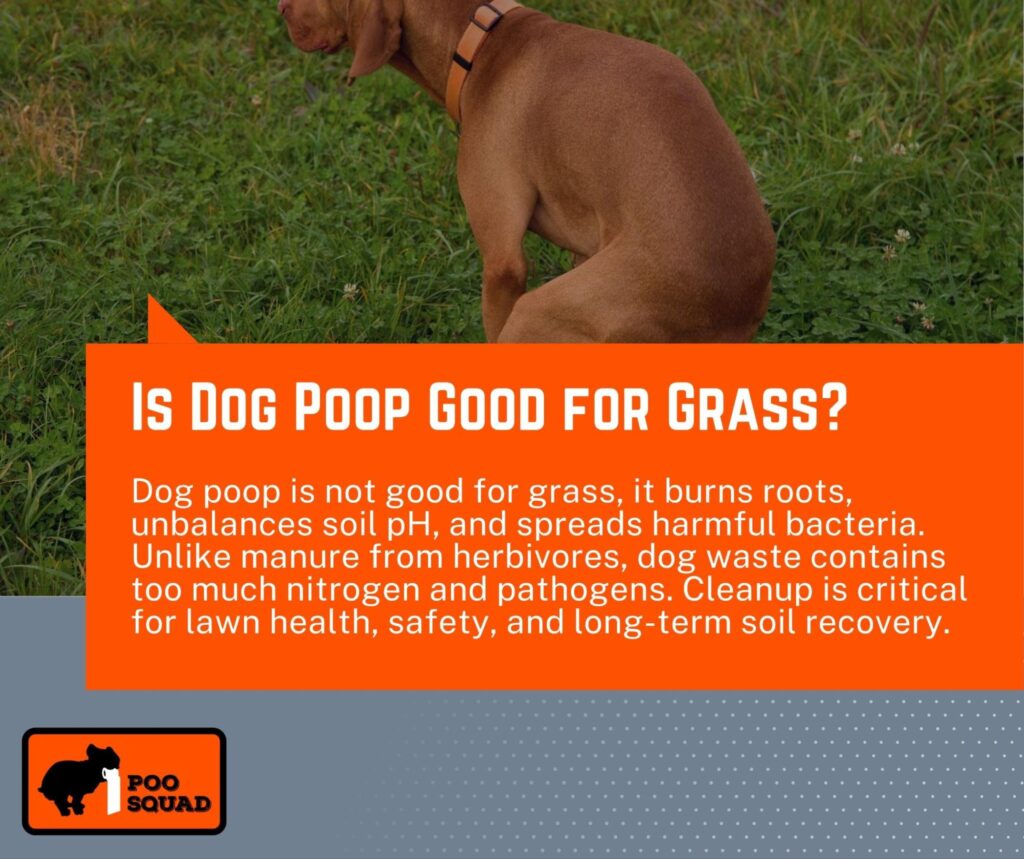
Unlike cow or horse waste, which is high in fiber and plant residue, dog poop is acidic, protein-heavy, and overloaded with nitrogen. That means instead of enriching your soil, it scorches your lawn from the root up.
If you’ve ever noticed a bright green circle around a fresh pile that turns yellow days later, that’s not health, it’s nitrogen burn.
And it only gets worse from there. Dog waste also contains millions of bacteria and parasites, including E. coli and roundworm eggs, which survive in the soil long after the poop is gone. That’s a hazard for your grass, your family, and your pets.
Today, we’ll unpack the science behind why dog poop kills lawns, expose the most common cleanup mistakes homeowners make, and walk you through real solutions, from damage control to prevention and professional help.
Whether your lawn’s already suffering or you’re trying to protect it before things get worse, this is the no-nonsense breakdown every dog owner should read.
Why Dog Poop Isn’t Fertilizer, Despite What You’ve Heard
Let’s put this myth to bed: just because poop comes from an animal doesn’t mean your grass wants it. People hear the word “manure” and think any backyard deposit must be good for growth. But dog poop closer to toxic waste for your lawn.
Here’s the key difference: herbivores like cows and horses eat grass, and their waste is full of fiber and digested plant matter. It breaks down cleanly and enriches the soil. Dogs, on the other hand, are omnivores. Their waste is acidic, high in protein byproducts, and packed with nitrogen, so much that it overloads and burns the grass roots.
That lush, green circle you sometimes see right after a dog goes?
It’s not a good sign. It’s the lawn equivalent of a sugar rush before a crash. The nitrogen surge forces the grass to grow fast, but the overdose turns toxic. Within days, the area starts yellowing, then browning out completely. That little green halo was the beginning of the end.
And it’s not just the nitrogen. The pH levels in dog poop lean acidic, which throws off soil chemistry and makes it harder for grass to absorb nutrients. Add in the bacteria and parasites still active in the waste, and you’re not fertilizing, you’re poisoning.
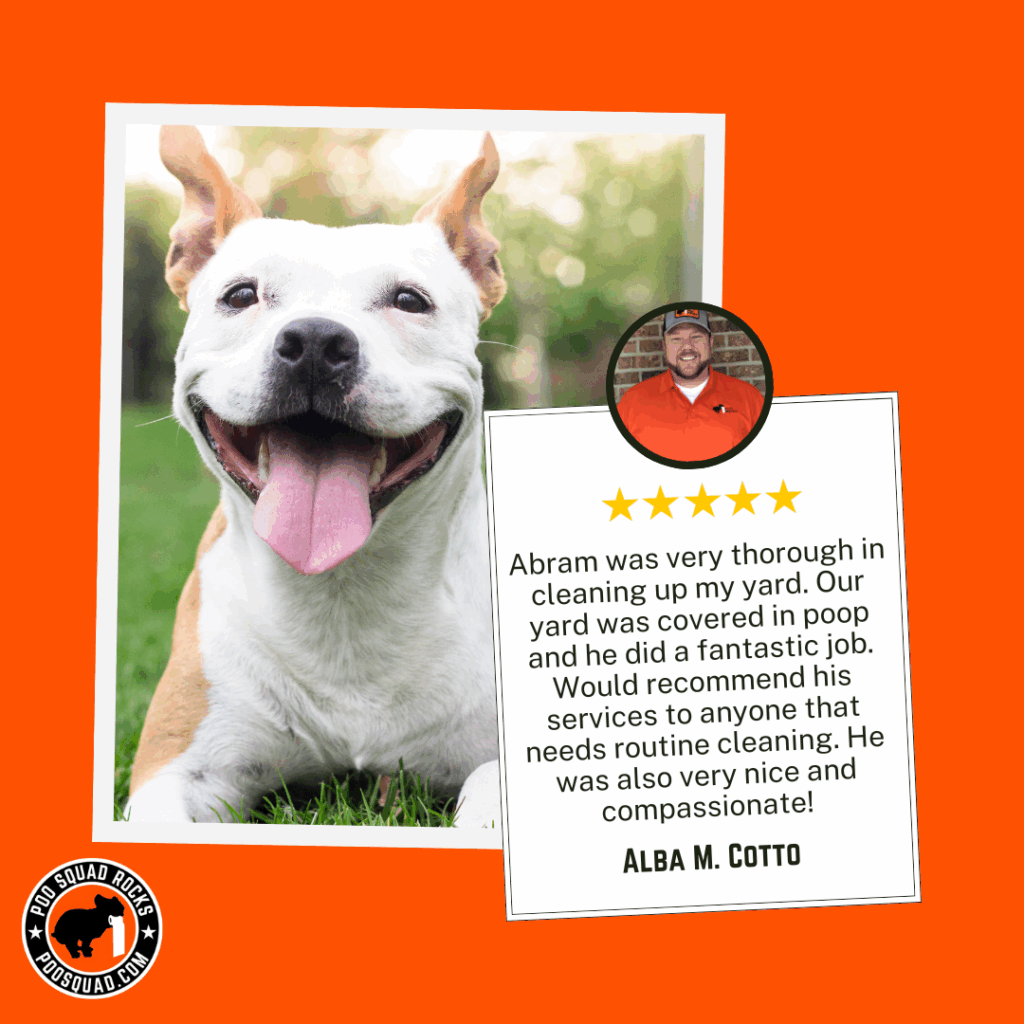
What makes it worse is how sneaky the damage can be. By the time you realize the poop was a problem, the root zone is already scorched, and you’re stuck reseeding or patching again. It’s cheaper, easier, and way more pleasant to just scoop daily, or have a team handle it for you without setting foot in your garage or touching your tools.
How Dog Poop Damages Your Lawn, Scientifically
There’s a reason your grass keeps dying in the same spot, and it’s not bad luck; it’s biology. Dog poop affects lawns in multiple destructive stages, and most of the damage is already done before you realize it.
Nitrogen Burn Explained
It starts with a dark green ring. You think, “Wow, the lawn looks great here!” That’s nitrogen overload at work. Dog waste contains way too much of it, especially for small, confined patches. The grass shoots up fast, then it fizzles.
From lush green, the area fades to yellow, then browns out completely. This is chemical burn, the same kind of lawn damage you get from over-fertilizing or, ironically, dog urine. Combine the two, and you’ve got overlapping zones of destruction, usually right where your pup likes to go every single time.
Toxic Bacteria & Soil Contamination
Even if you pick it up quickly, dog waste still leaves behind bacteria, millions of them. We’re talking E. coli, coliform, salmonella, and all the microscopic guests you don’t want near your shoes, pets, or kids.
These pathogens don’t just hang around for a day or two. Depending on moisture, sun exposure, and temperature, bacteria can linger in the soil for weeks. One gram of dog poop can contain over 23 million fecal bacteria, and lawns are rarely one-poop problems.
Persistent Lawn Recovery Issues
Here’s the part no one talks about: even after you clean the area and reseed it, the grass still refuses to grow.
Why?
When poop keeps hitting the same zone, the bacteria and acidity build up. The soil becomes compacted and unbalanced, with microbial ecosystems thrown off-kilter. Microbes that grass depends on to thrive are suffocated by the overload of nitrogen and pathogens.
The result?
Spot never recovers. You rake, you reseed, you water, and it just keeps dying.
If this sounds familiar, you’re not alone. Plenty of people try the DIY route, thinking a little dirt and seed will fix things. It won’t, not until the root issue is gone (pun intended).
Hidden Risks: It’s Not Just About the Grass
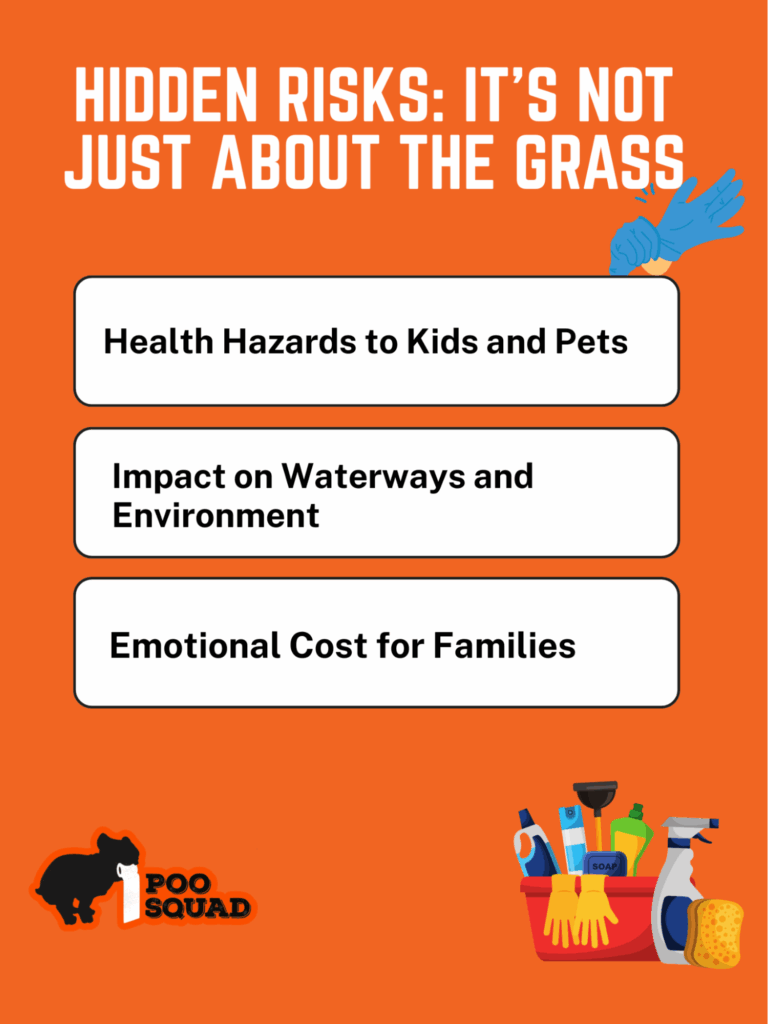
Lawn damage is the obvious problem, but it’s far from the only one. What dog poop does to your soil is just the beginning, its ripple effects touch health, home life, and even the neighborhood around you.
Health Hazards to Kids and Pets
When you leave waste in the yard, even for a few days, it becomes a biological minefield. Roundworms and hookworms are commonly found in dog feces, and their eggs can survive in soil for weeks or even months. These parasites can be transmitted to humans, especially small children who crawl or play on the lawn.
Toxocariasis is another risk. It can cause fever, cough, or more serious complications if the larvae migrate through the body. This stuff doesn’t disappear just because the poop is gone. It sticks to shoes, paws, toys, and bare feet.
If you’ve ever wondered how long you need to wait before letting your toddler back out on freshly scooped grass, the truth is, it depends on how thoroughly the area was cleaned. A visible pickup doesn’t mean the pathogens are gone. A proper service uses sanitized tools and often provides follow-up treatments, minimizing risk without making you second-guess your parenting.
Impact on Waterways and Environment
The EPA has classified pet waste as a pollutant in the same category as oil and toxic chemicals. When it rains, any poop left on the lawn gets washed into storm drains. From there, it flows untreated into rivers, lakes, and streams.
In suburban areas with compact neighborhoods, the effect is multiplied. One or two piles here and there quickly become a community-wide runoff issue.
Nutrient pollution leads to algae blooms, fish die-offs, and unsafe swimming conditions. It’s the kind of environmental footprint that rarely gets noticed, until it’s too late.
Emotional Cost for Families
Then there’s the mental load. The one no one talks about.
Some people treat poop duty like a harmless household chore. But for a lot of families, it’s the final straw. Arguments start over whose turn it is. It gets ignored. Then it piles up. Weekends are wasted, and frustration turns into resentment.
One family once said they were on the brink of breaking down over it. The day someone else handled the job for them, they cried in relief. Not because of the waste, but because of what it represented: one less thing to argue about. One less thing to feel guilty for.
And it’s not just about what’s happening inside the house. Outside, the smell lingers. The brown patches stand out. Neighbors notice. Delivery drivers notice. You notice, every time you step outside and pretend not to care.
The emotional toll of a messy yard weighs heavier than people admit. But once it’s lifted, the difference is immediate.
Common Mistakes People Make (and Regret)
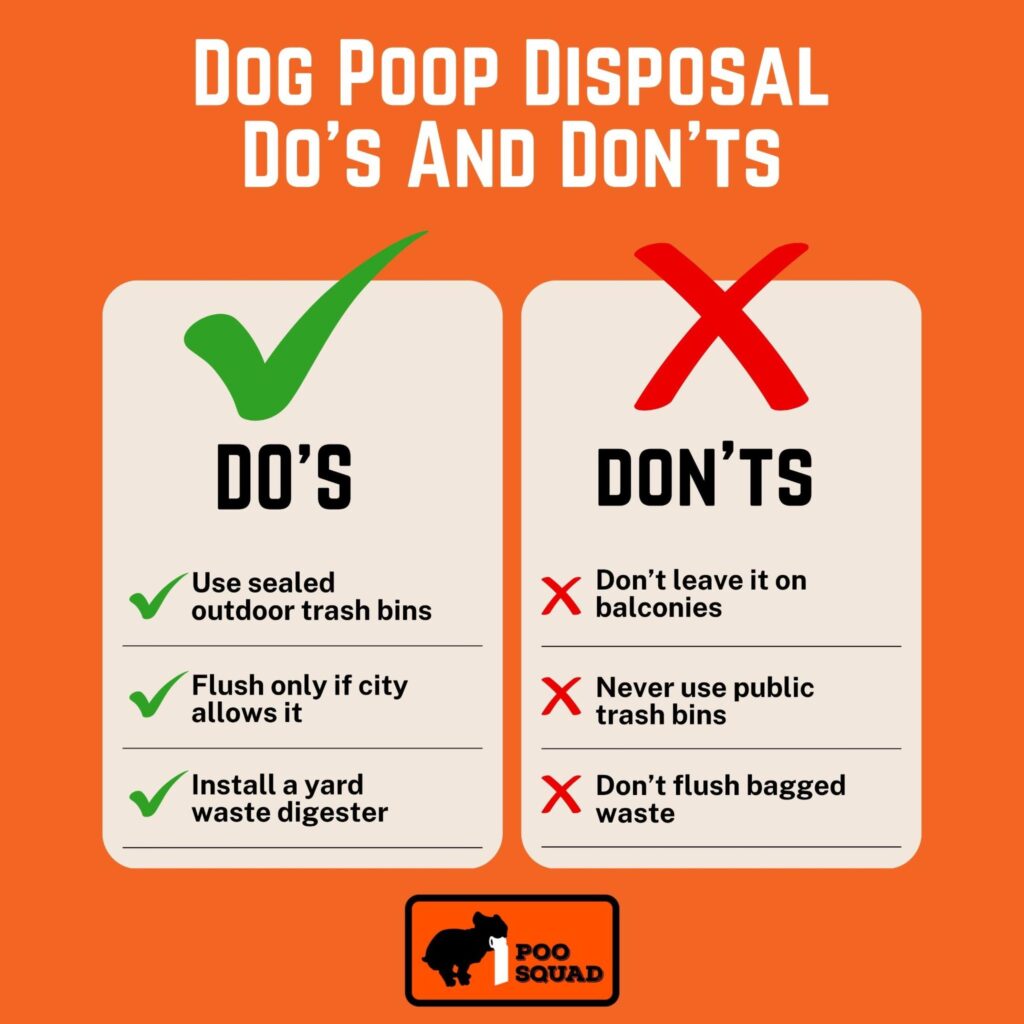
Even well-meaning dog owners fall into habits that quietly destroy their lawns. These missteps seem harmless at the moment, but they have long-term consequences for grass health, soil quality, and even your lawn equipment.
Mowing Over Poop
Ask anyone who’s done this once and they’ll never do it again.
Running a mower over hidden piles doesn’t just smear the mess; it blasts bacteria into the blades, the deck, and the air. It clogs up machinery, slings particles across your yard, and turns the cleanup into a biohazard.
Worse, the mower spreads infected fragments across a wider surface area. So instead of killing one patch of grass, you’ve now fertilized an entire section with a lawn-killing cocktail of nitrogen, pathogens, and shame.
Rinsing or Leaving It to “Compost”
Some homeowners try to wash poop into the ground with a hose, thinking it’ll break down faster or somehow “disappear.” Others leave it out, hoping nature will handle the decomposition. In reality, this takes weeks, sometimes months.
Unlike plant-based compost, dog waste requires high heat to safely decompose, which your average backyard doesn’t provide. Left alone, it leaches toxins and bacteria deep into the root zone, where they continue doing damage long after the pile is gone.
Some folks even try using lime to “neutralize” the spot. But it’s not a magic fix. Lime can temporarily balance pH levels, but it won’t disinfect the area or undo nitrogen burn. Used improperly, lime can make things worse, drying out soil or locking nutrients away from your grass.
Assuming Winter Freezes Solve the Problem
Cold weather doesn’t kill off the bacteria. It just pauses the damage.
Poop left out in freezing temperatures becomes a landmine come spring. As the thaw hits, so does the stink and the pathogens. What looks like harmless frozen piles are ticking time bombs of decay, set to leak into your soil as soon as the weather warms up.
That’s why late winter and early spring are some of the worst times for lawn recovery. Homeowners assume nothing’s happening under the snow. Meanwhile, the grass is suffocating under frozen waste, and the soil beneath is quietly souring.
How Poo Squad Helps You Avoid All This
The difference between picking up after your dog and outsourcing it to a professional might seem small until you experience the relief of never thinking about it again. It’s peace of mind, preventative health insight, and time back in your day.
More Than a Poop Pickup Service
This service goes beyond scooping and tossing. Each visit includes a Dog Poop Report Card, an observational log of your dog’s waste, because irregularities can be the first sign of health issues. If something looks off, you’re notified. Most people never think to check, but it can make all the difference.
After every job, there’s a triple gate check: not once, not twice, but three times to make sure your yard is secure before leaving.
You also get a photo confirmation, so you’re not wondering whether your dog’s safe or your gate’s swinging open in the wind.
The crew doesn’t show up in random cars or street clothes either. Every technician is in a bright orange uniform, arriving in a branded truck. They sanitize tools and even their shoes between yards, so bacteria don’t hitch a ride from one house to the next. Their badges are scannable, verified by QR, so you always know who’s at your property.
That’s how it should be when someone comes into your yard.
For Families, It’s About Sanity Too
There’s a story of a customer who cried when they came home to a clean yard. Not because they hate poop (though they probably do), but because it had been weighing on them for weeks.
No one else in the family would do it. Every weekend brought a new argument. When it was finally handled, they felt like they could breathe again.
For families facing difficulty with work, parenting, errands, and dinner by 6:30, handing off one gross task can feel like winning the lottery.
And for folks with mobility issues or health concerns, who want to keep their pets but can’t physically manage cleanup, it’s more than a convenience. It’s dignity.
What To Do If Your Lawn Is Already Damaged
Let’s say the damage is done. Brown patches have spread, nothing’s growing back, and the smell lingers longer than it should.
The good news?
Most lawns can recover. But like anything worth fixing, it takes more than a weekend and a bag of seed.
Short-Term Fixes
Start by clearing out the mess, completely. Any lingering waste, even fragments, will keep leaching nitrogen and bacteria into the soil. Don’t just scoop and run. Lightly water the area to flush out surface-level residue and begin the recovery process.
Next, consider applying a pet-safe lawn treatment. There are targeted products that help neutralize nitrogen and promote healing, especially when used right after removal. Just make sure whatever you use won’t harm pets who play or roll around on the grass afterward.
Long-Term Recovery Plan
If the grass keeps dying in the same spot, it’s not just about the surface anymore; it’s your soil. Over time, repeated exposure to waste alters the soil’s pH, making it too acidic for grass to thrive. A simple soil test can confirm what’s off-balance.
To correct it, start with pH-balancing amendments like lime or gypsum, used carefully and in measured doses. Then comes aeration, loosening compacted soil and allowing oxygen, nutrients, and water to reach the roots. Finally, overseed with a durable grass variety like tall fescue or Kentucky bluegrass, giving your lawn a better shot at bouncing back.
Be patient. Healthy lawns aren’t built overnight, but they can be rebuilt with consistency.
Prevention First
If your dog has a favorite spot, embrace it. Create a designated potty zone with mulch, gravel, or a patch of artificial turf. It channels the damage into one area that’s easier to clean and less painful to look at.
Training your dog to avoid the main lawn takes time, but it’s worth it. Use leash guidance, treats, and repetition. Before long, you’ll have one tidy zone instead of a battlefield of brown circles.
And if the idea of keeping up with all this is already stressing you out, some services can handle it quietly, cleanly, and consistently. It doesn’t just save your yard. It saves your weekends.
Dog Poop Is a Problem, Not a Fertilizer

For all the myths out there, here’s the reality: dog poop doesn’t help your grass, it hurts it. It burns through root systems, poisons your soil, spreads bacteria, and leaves behind a lawn that looks worse every time you try to fix it.
Fertilizer builds things up. Dog waste breaks things down.
If you’ve ever mowed over a forgotten pile, watched your grass collapse into brown circles, or dreaded the spring thaw because you know what’s waiting under the snow, you already understand. It’s a recurring problem that quietly erodes your yard, your time, and your peace of mind.
For your lawn, your health, and your sanity, don’t leave it behind. Whether you scoop it yourself or get help from someone who shows up, cleans up, and checks every gate on the way out, it’s one of the simplest ways to protect your property and the people who use it.
Still Wondering About Your Lawn? Poo Squad Can Help
If you’ve made it this far, you already care about your yard, and that’s half the battle. The other half? Consistency. That’s where a reliable cleanup crew can make all the difference.
Book Your First Pickup Today
Thousands of families across the country are choosing a new way to handle an old problem. Bright-orange trucks, background-checked techs, and a customer experience that feels personal, it’s why the reviews read like thank-you notes.
You can check out what folks are saying on Google and Facebook. They’re not just praising clean lawns, they’re talking about saved weekends, fixed family routines, and a whole lot more peace of mind.
Whether you’re in a quiet cul-de-sac, a busy suburban neighborhood, or managing properties with pets all over the place, this is the kind of service that shows up when it says it will, handles the job, and gets out without a trace (except for maybe a thank-you video).
Licensed. Insured. Local to your community.
If you’re ready to stop arguing over poop duty and start protecting your lawn, it starts with one click: Book your first pickup now.
Questions Pet Owners Are Asking, Answered
These are the kinds of questions that come up in neighborhood group chats and quiet backyard debates. They’re real, specific, and grounded in lived experience. Let’s clear the air.
Can composted dog poop ever be used on flowers?
Technically, yes, but only if you’re using a high-heat composting system designed to kill off pathogens. The kind of backyard pile you throw leaves and banana peels into? That won’t cut it. Dog waste needs sustained temperatures over 145°F to safely break down. Without that, you’re just spreading bacteria onto your plants and into the soil. Keep it away from anything that blooms, fruits, or grows near foot traffic.
Are some grass types resistant to poop damage?
Certain grasses, like tall fescue or Kentucky bluegrass, tend to bounce back a little faster. They have deeper root systems and a bit more resilience to stress. But even these aren’t immune. Regular exposure to waste will still burn them out over time. It’s less about picking the right grass and more about breaking the cycle of abuse.
What’s the best poop pickup schedule for lawn health?
The less time it sits, the better. Daily pickup is ideal if you want to avoid nitrogen burn, bacteria seepage, and odor buildup. At a minimum, shoot for once a week. Anything longer than that, and you’re practically inviting your lawn to rebel.
Consistency matters too. A well-timed pickup before it rains or snows prevents waste from soaking deeper into the ground. And if you’re not the one doing it, make sure whoever follows through every single time. Spotty service leads to spotty grass.
Do dog parks or HOAs allow poop fertilization?
Not. Most have rules against even minor infractions. Some HOAs fine residents for visible waste or brown spots from pet damage. Dog parks are even stricter. They require clean-up on site to protect public health, avoid runoff issues, and keep the space usable for everyone.
If fertilizing with pet waste were truly effective or safe, these community green spaces would be the first to promote it. Instead, they treat it like a liability. That should tell you everything you need to know.
